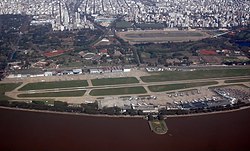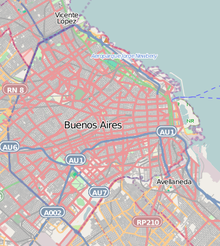Aeroparque Jorge Newbery
Jorge Newbery Airfield Aeroparque "Jorge Newbery" | |||||||||||
|---|---|---|---|---|---|---|---|---|---|---|---|
 | |||||||||||
| Summary | |||||||||||
| Airport type | Public / Military | ||||||||||
| Operator | Aeropuertos Argentina 2000 S.A. | ||||||||||
| Serves | Buenos Aires, Argentina | ||||||||||
| Elevation AMSL | 5 m / 18 ft | ||||||||||
| Coordinates | 34°33′32″S 058°24′59″W / 34.55889°S 58.41639°W | ||||||||||
| Map | |||||||||||
 | |||||||||||
| Runways | |||||||||||
| |||||||||||
| Statistics (2014) | |||||||||||
| |||||||||||
Jorge Newbery Airfield (Template:Lang-es, IATA: AEP, ICAO: SABE) is an international airport located in Palermo neighbourhood, 2 km (1.2 mi) northeast of downtown Buenos Aires, Argentina.[2] The airport covers an area of 138 hectares (341 acres) and is operated by Aeropuertos Argentina 2000 S.A.[3] It is located in the Palermo ward, along the Río de la Plata, and serves as the main hub for domestic flights from Buenos Aires as well as to Uruguay, Bolivia, Brazil, Chile and Paraguay. The airport is named in honor of Argentine aviator Jorge Newbery.
The Argentine Air Force Station located on the eastern end of the airport is where authorities normally board the Tango 01 presidential aircraft.
Newbery Airfield is roughly equal to Ezeiza International Airport (located 38 km (24 mi) to the south) in airline traffic among the nation's 33 airports, handling 93,346 aircraft movements in 2009 and serving 10,255,541 passengers in 2014 (one third of all scheduled air traffic in Argentina, the first Argentine airport to pass the 10 million passenger mark in history); it thus surpassed Ezeiza International in 2013 as the nation's busiest airport by passenger traffic.[4] In 2015, Aeroparque Jorge Newbery was again Argentina's busiest airport, having handled 11,052,861 passengers, relegating Ezeiza International Airport again to the second place, with 9,127,908 passengers handled.
History
The airport was originally proposed by Mayor Carlos Noël in 1925.[5] A number of feasibility studies and zoning disputes followed. In 1938, plans were submitted for an island airport connected via causeway to Avenida General Paz (then under construction).[6] A former wetland reclaimed in 1916 from the Río de la Plata and closer to downtown was selected instead, and the facility, designed by Aeronatics Secretariat engineer Víctor Acuña in 1945, was inaugurated in 1947 as Aeroparque 17 de Octubre (17 October Airfield).[7]
Initially served by a 1,000 m (3,300 ft) runway, it began operations in January 1948 as the main hub for domestic flights from Buenos Aires as well as flights to Uruguay. Its first terminal was completed in 1951, by which time the runway was extended to 1,550 m (5,090 ft).[8] The airport was renamed following the 1955 coup against President Juan Perón in honor of the pioneer of Argentine aviation, Jorge Newbery, and was re-inaugurated in 1960 following work that expanded its main runway to 2,070 m (6,790 ft) and added a new terminal.[7] The Argentine Air Force had a small base built near the eastern end of the airport in 1965;[9] it was at this site that President Isabel Perón was formally deposed by the military in the March 1976 coup.[10] A new terminal for national air carrier Aerolíneas Argentinas was inaugurated in 1981, expanding total terminal area to 30,000 m2 (320,000 sq ft).[8]
Plans to merge Newbery with Ezeiza International Airport in a new facility located on an artificial island were revived in 1996 by a commission headed by Congressman Álvaro Alsogaray, though these plans were ultimately dropped.[6] Its operations, like those of all the nation's public airports, were privatized in 1998 and transferred to Aeropuertos Argentina 2000 (part of the conglomerate owned by local businessman Eduardo Eurnekian).[8] The runway was further extended by 180 m (590 ft) in 2007,[11] and work began in 2009 to create greater distance between the nearby Rafael Obligado Coast Highway and the eastern end of the runway.[12] Routes were added in March 2010 to destinations in Brazil, Chile, and Paraguay.[13] Work began in 2011 on Terminals III and IV, totaling 35,000 m2 (380,000 sq ft).[14] These terminals were inaugurated in March 2014, effectively doubling the airport's passenger capacity.[15]
Airlines and destinations
Statistics


| Passengers | Change from previous year | Aircraft operations | Change from previous year | Cargo (metric tons) |
Change from previous year | |
|---|---|---|---|---|---|---|
| 2000 | 6,187,563 | N.A. | N.A. | N.A. | N.A. | |
| 2001 | 4,411,179 | N.A. | N.A. | N.A. | N.A. | |
| 2002 | 3,891,699 | N.A. | N.A. | N.A. | N.A. | |
| 2003 | 5,342,894 | N.A. | N.A. | N.A. | N.A. | |
| 2004 | 5,245,923 | 84,844 | N.A. | 30,312 | N.A. | |
| 2005 | 5,372,195 | 77,742 | 26,415 | |||
| 2006 | 5,289,074 | 79,223 | 13,471 | |||
| 2007 | 5,665,808 | 81,340 | 14,078 | |||
| 2008 | 5,687,221 | 85,793 | 14,690 | |||
| 2009 | 6,449,344 | 91,676 | 13,700 | |||
| 2010 | 7,558,149 | 104,857 | 18,945 | |||
| 2011 | 8,250,971 | N.A. | N.A. | N.A. | N.A. | |
| 2012 | 8,849,465 | N.A. | N.A. | N.A. | N.A. | |
| 2013 | 9,552,504 | N.A. | N.A. | N.A. | N.A. | |
| Source: Airports Council International: World Airport Traffic Report (Years 2005-2010) and other sources.[4][5] | ||||||
Accidents and incidents
This section needs additional citations for verification. (October 2011) |
- On 17 December 1969, an Austral Líneas Aéreas C-46 Commando lost engine 1 due to fuel exhaustion shortly after takeoff. The plane failed to gain height and made a crash landing in a small sport field. Both of the crew members survived without injury.
- On 11 May 1975, Vickers Viscount CX-AQO of PLUNA was damaged beyond economic repair when it departed the runway.[17]
- On 27 January 1978, an Austral Líneas Aéreas BAC 1-11 was damaged by an oxygen tank that caught fire. Nobody was injured.
- On 7 May 1981, Austral Líneas Aéreas Flight 901, a BAC 1-11, crashed on approach after a flight from Tucumán. All 31 passengers and crew were killed.
- On 31 August 1999, LAPA Flight 3142, a Boeing 737-200, crashed shortly after takeoff due to pilot error. 63 of the 100 passengers and crew were killed. Two people on the ground were also killed, raising the death toll to 65.
References
- ^ http://www.aeropuertosarg.com.ar/2015/02/trafico-de-pasajeros-en-aeropuertos-de-aa2000-crecio-54-en-2014/
- ^ a b Template:Es icon "SABE AEROPARQUE JORGE NEWBERY" (PDF). (1774 kB) at AIP Argentina
- ^ a b Template:Es icon Aeroparque at Organismo Regulador del Sistema Nacional de Aeropuertos (ORSNA)
- ^ a b "Aumento del 4.4 por ciento en el tráfico de pasajeros en 2013". Aeropuertos Argentina 2000. 14 January 2014.
- ^ a b "Aeroparque Jorge Newbery". Atlas Ambiental de Buenos Aires.
- ^ a b "Aeroparque no se muda, aunque sí se modifica". La Nación. 14 April 2004.
- ^ a b "Un moderno aeropuerto a 15 minutos del centro". Correo de la Tarde. 18 January 1960.
- ^ a b c Reznik, Constanza (2008). "Proyecto de graduación – Seguridad aeroportuaria" (PDF). Universidad de Palermo.
- ^ "Fuerza Aérea: Guarniciones y unidades". Aeromilitaria Argentina.
- ^ Lewis, Paul (2002). Guerrillas and Generals. University of North Carolina Press. p. 127. ISBN 0-275-97360-3.
- ^ "Avanza con demoras el plan para ampliar la pista de Aeroparque". Clarín. 20 July 2007.
- ^ "No avanza la extensión de la autopista Illia hacia el Norte". Clarín. 25 March 2010.
- ^ "Ya operan desde Aeroparque los vuelos a países limítrofes". Los Andes. 15 March 2010.
- ^ "Nuevas obras en el Aeroparque Jorge Newbery". Helport. 10 May 2011.
- ^ "Cristina destacó la transformación del aeroparque "desde que se incremento la economía y el turismo". Telam. 26 March 2014.
- ^ http://www.routesonline.com/news/38/airlineroute/269528/amaszonas-plans-buenos-aires-punta-del-este-route-from-dec-2016/
- ^ "Accident description". Aviation Safety Network. Retrieved 8 October 2009.
External links
![]() Media related to Aeroparque Jorge Newbery at Wikimedia Commons
Media related to Aeroparque Jorge Newbery at Wikimedia Commons

